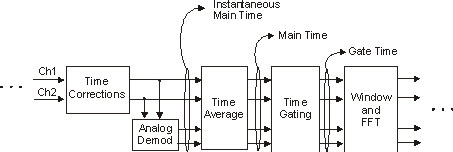Main Time (Trace Data)
shows the selected channel's main time-record.
is only available when the measurement type is or .
For digital modulation measurement types, the time record that is demodulated is shown in the trace. For more information about the trace, see the trace topic for the respective digital demodulator listed in Optional Measurement Software Trace Data.
Main Time versus Gate Time
The term "main time-record" may be new. This term is used to differentiate between the "main" time record and the "gate" time record when time gating is on.
A time record is the basic building block of the Fast Fourier Transform (FFT Fast Fourier Transform: A mathematical operation performed on a time-domain signal to yield the individual spectral components that constitute the signal. See Spectrum.). The FFT takes the time-domain information in the time record and transforms the time data into the frequency domain.
When time gating is on, a portion of the main time-record can be identified to be used by the FFT. The term "main time-record" identifies the entire time record; the term "gate time-record" identifies the portion selected by the gate.
The trace data shows the entire time record--the main time-record. Selecting the Gate Time trace data displays that portion of the main time-record marked by the gate--the gate time-record.
The following block diagram shows the blocks that create main time and gate time. This is a portion of the VSA Block Diagram.
The Analog Demod block in the following diagram is available only when the measurement type is set to Analog Demodulation.

Reasons for Displaying the Time Record
There are many reasons to view the main time record. Here are just a few:
- To verify that there is an input signal
- To see the characteristics of the input signal
- To help in manually setting the input range
Time Records and Span
If the measurement hardware is set to full span, the time data seen is the actual input time-record. This is raw input data--the signal from which all subsequent measurements are based.
If the measurement hardware is set to measure a specific bandwidth (something less than full span), the time data seen is the raw input data after filtering (to provide alias protection) and decimation (to obtain the desired span).
Time Records and Averaging
When RMS or Peak Hold/Continuous Peak Hold averaging is on, the VSA displays the most recent time record. The trace does not show an averaged time waveform because these types of averaging are done after the time data has been transformed to the frequency domain.
When time averaging is on, the trace shows the averaged time-record. In other words, the time record has been averaged with previous time records.
How the VSA Displays the Time Record
It is important to remember that although the time record looks like an oscilloscope display, the VSA is not a digital oscilloscope.
The time record represents samples of a waveform. The samples have enough information to accurately reconstruct the input signal--but the human eye may not properly perform the reconstruction. In fact, for frequencies that are higher than about ten percent of the frequency span, there will be noticeable visible distortion.
The VSA's anti-alias filters will cause some ringing or distortion of square waves or transients when viewed in the time domain.
See Also
